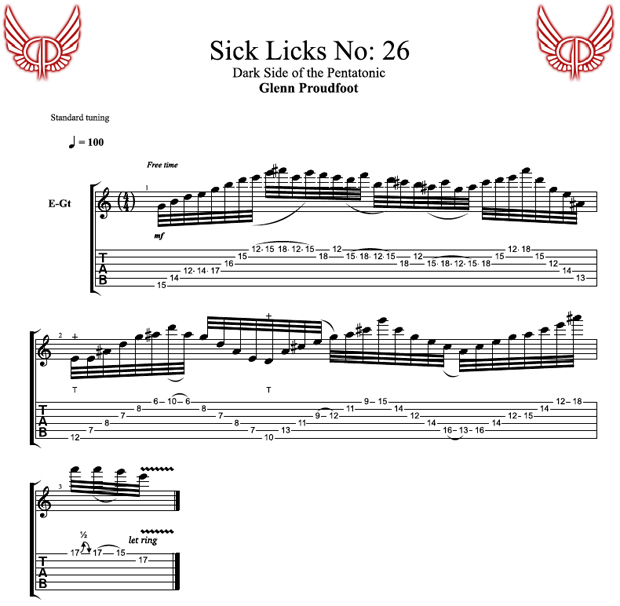Sick Licks: The Dark Side of the Pentatonic Scale

This Sick Lick is based around the E pentatonic scale and the diminished 7th scale.
The more you explore the possibilities tonally with soloing, the more you realize you can pretty much use any note on the fretboard as a passing note in any given key.
As you might know, jazz guitarists are the masters of using passing notes. You can apply the same thinking and technique to rock soloing. Although this sounds easy in theory, in reality, it isn’t. A lot of thought has to go into it, because it is very easy to get this horribly wrong.
First, you need total command over the guitar tonally. By this I mean you must know your scales. The most important thing when developing an “outside” sound or using passing notes is having the ability to not get lost in it and be able to move quickly and freely between the passing notes and the scales.
Most guitarists do this in some way, shape or form anyway. With the pentatonic blues scale, the flat 5 is a passing note. The example I've given below takes it to another level. This style, for me, was heavily inspired by Shawn Lane. Shawn’s playing was a major influence on me. He really pushed the boundaries tonally and had the most incredible technique — a total master!
The lick:
I start this lick with a straight pentatonic sweeping pattern that starts on the low E and finishes on the high E on the 12th fret. From here I move into a legato pattern. The first legato pattern is using the pentatonic blues scale, as I use the flat five on the 18th fret (B flat) instead of the A on the 17th fret. This sets up the “outside” sound section.
All the latest guitar news, interviews, lessons, reviews, deals and more, direct to your inbox!
What I do from here is play the same legato pattern and same fingerings on the B string that I do on the high E. This creates the “outside” sound. Now it is the (F) on the B-string 18th fret that is the “outside” note. The reason this works is that the F note in the key of E is found in the Phrygian and Locrian modes. By itself, it sounds completely wrong, but used in a certain fashion, it can have an amazing effect! From there I do the same again on the G string. The notes that appear on the G string are actually in the diminished 7th arpeggio, which I am using for this lick.
When you analyze this, you can see that it is the only the F note that is actually creating the “outside” sound. Now, as this note is not commonly used in the key of E minor in rock soloing it has a very powerful effect and really stands out. As I mentioned above, in order to make this work, you need to be able to tie it into your playing smoothly and cleverly.
This is a great way to start exploring this tonal technique. The remainder of the lick is using the E blues and diminished 7th scales. There are some crazy transitions and an “over the top” section. The important thing is to be aware of the note marked "T" on the transcription below. This is the note I fret with my left thumb to create the pivot to swing my left hand over the top. I do the same thing to switch it back to the traditional position.
I hope you enjoy! Please join me on YouTube here.

Australia's Glenn Proudfoot has played and toured with major signed bands and artists in Europe and Australia, including progressive rockers Prazsky Vyber. Glenn released his first instrumental solo album, Lick Em, in 2010. It is available on iTunes and at glennproudfoot.com. Glenn was featured in the October 2010 issue of Guitar World and now creates "Betcha Can’t Play This" segments and lessons for GW. Glenn also has a monthly GW column, "Loud & Proud," which offers insight into his style and approach to the guitar. Glenn is working on a project with Ezekiel Ox (ex Mammal) and Lucius Borich (Cog), which is managed by Ted Gardner, ex-Tool and Jane's Addiction manager. The band has done pre-production on 22 tracks and is set to hit the studio and finish their first studio album. The album is set for release in 2012. Glenn also is working on the followup to his debut album; it, too, will be released in 2012.
